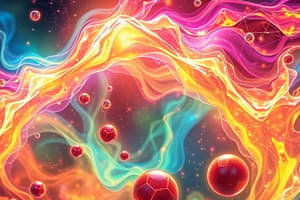Podcast
Questions and Answers
What type of bonding is characteristic of metallic compounds?
What type of bonding is characteristic of metallic compounds?
- Covalent bonding
- Metallic bonding (correct)
- Hydrogen bonding
- Ionic bonding
Which category of inorganic compounds involves the interaction of a central metal ion with various ligands?
Which category of inorganic compounds involves the interaction of a central metal ion with various ligands?
- Oxides
- Salts
- Acids and Bases
- Coordination Compounds (correct)
What do acids and bases do in a solution?
What do acids and bases do in a solution?
- React with metals to form salts
- Release oxygen
- Donate or accept protons (correct)
- Increase conductivity
Inorganic materials like ceramics and semiconductors are commonly used in which field?
Inorganic materials like ceramics and semiconductors are commonly used in which field?
What real-world application of inorganic chemistry involves understanding and mitigating air and water pollution?
What real-world application of inorganic chemistry involves understanding and mitigating air and water pollution?
Which of the following is not a common classification of inorganic compounds?
Which of the following is not a common classification of inorganic compounds?
What types of elements are focused on in inorganic chemistry?
What types of elements are focused on in inorganic chemistry?
Which type of bonding involves the sharing of electrons between two atoms?
Which type of bonding involves the sharing of electrons between two atoms?
What are the primary types of bonding found in inorganic compounds?
What are the primary types of bonding found in inorganic compounds?
Which type of bonding involves the transfer of electrons between a metal and a non-metal?
Which type of bonding involves the transfer of electrons between a metal and a non-metal?
Which elements are part of inorganic chemistry based on the periodic table?
Which elements are part of inorganic chemistry based on the periodic table?
What determines the behavior of inorganic compounds?
What determines the behavior of inorganic compounds?
Flashcards are hidden until you start studying
Study Notes
Exploring the World of Inorganic Chemistry
Inorganic chemistry, a fascinating and diverse branch of science, centers around the properties, reactions, and compounds of elements that are not carbon-based. This realm encompasses the exploration of minerals, metals, non-metals, and their interactions. Let's delve deeper into the captivating world of inorganic chemistry and uncover its intricacies.
The Elements of Inorganic Chemistry
Inorganic chemistry is concerned with the 18 non-carbon elements found in the periodic table's first 18 columns. These elements include hydrogen, helium, the alkali metals, the alkaline earth metals, metalloids, and the transition metals. Each of these elements has unique characteristics and properties that shape the behavior of inorganic compounds.
Compounds and Bonding
Inorganic compounds are formed through covalent, ionic, or metallic bonding, which are the primary types of bonding found within this realm. These bonds develop as electrons are shared, transferred, or delocalized among atoms to create stable structures.
- Covalent Bonding: Occurs when two atoms share electrons to achieve a stable electron configuration. This type of bonding is common among non-metals and metalloids.
- Ionic Bonding: Results from the transfer of electrons between a metal and a non-metal, creating ions with opposite charges that are attracted to each other. This type of bonding is characteristic of ionic compounds.
- Metallic Bonding: Involves the delocalization of electrons among metal atoms, creating a stable "sea of electrons." This type of bonding is characteristic of metallic compounds.
Common Classifications of Inorganic Compounds
Inorganic compounds can be classified into various categories, including:
- Salts: Ionic compounds formed between a metal and a non-metal, yielding an anion and a cation. The specific type of salt is determined by the charge of the ions and the arrangement of their lattice structure.
- Acids and Bases: Compounds that donate or accept protons, affecting the pH of a solution.
- Coordination Compounds: Involve the interaction of a central metal ion with various ligands, forming a stable complex. The properties of coordination compounds are often colorful and diverse.
Applications of Inorganic Chemistry
The study of inorganic chemistry has significant real-world applications:
- Materials Science: Inorganic materials, such as ceramics and semiconductors, are used in various technologies, including electronics, energy storage, and aerospace engineering.
- Medicine: Inorganic compounds are utilized in the production of pharmaceuticals, radiopharmaceuticals, and medical imaging agents.
- Environment: Inorganic chemistry is essential in understanding and mitigating environmental issues, such as air and water pollution, and in the development of environmentally friendly technologies.
Inorganic chemistry is a fascinating and dynamic field that continues to grow and shape the world around us. With its diverse applications and fascinating compounds, it is a subject that offers endless opportunities for exploration and discovery.
Studying That Suits You
Use AI to generate personalized quizzes and flashcards to suit your learning preferences.



